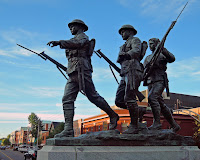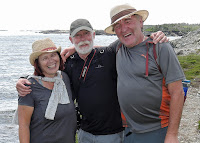 Mid-October seemed a good time for a solo walk in untraveled
woods. Some years ago – eight, ten, who can say? – Jan and Bob Nagel and I
invested a little effort in clearing out an old road on the eastern border of Robert’s
two hundred acres. Alone this time, without the navigational talent of my
better-half, I have no easy time in relocating the trailhead. I choose an
acceptable-looking entry point and commence to bushwhack. Our combined effort from
that time is now utterly indiscernible: I need not have it pointed out that nature
harbours neither regard nor sympathy for human works.
Mid-October seemed a good time for a solo walk in untraveled
woods. Some years ago – eight, ten, who can say? – Jan and Bob Nagel and I
invested a little effort in clearing out an old road on the eastern border of Robert’s
two hundred acres. Alone this time, without the navigational talent of my
better-half, I have no easy time in relocating the trailhead. I choose an
acceptable-looking entry point and commence to bushwhack. Our combined effort from
that time is now utterly indiscernible: I need not have it pointed out that nature
harbours neither regard nor sympathy for human works.
I make my through the forest tangle thinking of my old
friend. The rest of us imagined Robert had a portrait concealed in the attic: he was supposed
to outlive us all. Circumstance made other arrangements: this is the second
year that Herr Nagel has been absent from his woods.
 In spring this forest is alive with bird song. Now in autumn
warblers and thrushes are long departed to warmer climes but there is occasional
evidence I do not have the forest entirely to myself. Nuthatches, chickadees,
jays and kinglets initiate sporadic conversation. A red squirrel objects loudly to my passage.
A pileated woodpecker grumbles too but declines to indulge my wish for a photo
op. The remains of a ruffed grouse are more accommodating: a mess of feathers
disaggregated from the bones and flesh that constituted a living, breathing
whole perhaps as recently as yesterday. ‘What a sin’, Lynn and Louise might
observe, but goshawks need to eat too.
In spring this forest is alive with bird song. Now in autumn
warblers and thrushes are long departed to warmer climes but there is occasional
evidence I do not have the forest entirely to myself. Nuthatches, chickadees,
jays and kinglets initiate sporadic conversation. A red squirrel objects loudly to my passage.
A pileated woodpecker grumbles too but declines to indulge my wish for a photo
op. The remains of a ruffed grouse are more accommodating: a mess of feathers
disaggregated from the bones and flesh that constituted a living, breathing
whole perhaps as recently as yesterday. ‘What a sin’, Lynn and Louise might
observe, but goshawks need to eat too.
Robert Frost’s Mending
Wall comes to mind. Along Bob’s eastern line there is an old moss-covered
wall, looking intact in some sections, that divides whoever owned the land a century
and a half ago from his neighbour’s holding on the opposite side. When Canada
was young, I imagine, there were not woods here, but fields. I have no direct
evidence for the supposition, only the notion that the heart of a forest is a
strange place for a finely-made stone wall. “Something there is that doesn’t love a wall,” the poet observes. Here
on Bob’s line it is easy to see what that something could be.
Who built the wall? And when? Was it a MacKenzie or a
MacLeod? Was it both? On opposite sides of the old wall were MacKenzie and
MacLeod good neighbours? I like to think they may have been and fancy them
building the wall together to keep their cows on the right side of the line.
 Boularderie Island was farming country ten, fifteen decades
ago. In mind’s eye I see the neighbour-farmers maintaining the wall, tending
their fields, raising their families, living off the land. Whatever the fruits
of their labour back when, there is little sign of the fruits now. When in
older age did the neighbours go to their reward? How long did it take the
spruce and fir to begin reclaiming their due? Are MacKenzie-MacLeod descendants
anywhere in the neighbourhood? Nowadays it is clear these woods attract little
human traffic. Hmm, I think, I don`t have my cell phone: if I should keel over how
many years will it be before another bushwhacker stumbles upon my bones?
Boularderie Island was farming country ten, fifteen decades
ago. In mind’s eye I see the neighbour-farmers maintaining the wall, tending
their fields, raising their families, living off the land. Whatever the fruits
of their labour back when, there is little sign of the fruits now. When in
older age did the neighbours go to their reward? How long did it take the
spruce and fir to begin reclaiming their due? Are MacKenzie-MacLeod descendants
anywhere in the neighbourhood? Nowadays it is clear these woods attract little
human traffic. Hmm, I think, I don`t have my cell phone: if I should keel over how
many years will it be before another bushwhacker stumbles upon my bones?
The woods are shot through with colour: the scarlet and gold
of maple and birch, the myriad greens of the mosses underfoot. It has been a
banner year for mushrooms: Would that I could identify them all but my mycology
is weak. I can see that some are puffballs, some are shelf mushrooms but whether Bovista and Stereum I cannot say.
Looking and listening, I lose track of time as I slowly follow
the old wall. I stay close to the line,
reach a familiar bog and choose footfalls that look drier than others. Then the
reverie is over, I am at the back road to Dalem Lake, where there are houses
and the clamor of the big trucks on Highway 105 grows louder.
Allah willing, I will make a point of revisiting Bob’s woods
before another ten years unspool.

































